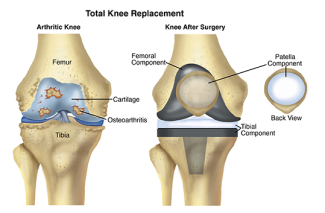
Rehabilitation Following Total Knee Replacement Surgery
Total knee replacement surgery, also known as total knee arthroplasty, is a common surgical procedure to replace the knee joint. This procedure involves cutting away the damaged cartilage and bone from the femur (thigh bone) and tibia (shin bone) and replacing it with an artificial joint (also known as a prothesis). Prosthetic pieces of metal are used to resurface the ends of the bones that form the knee joint.
People may undergo this surgical procedure for a number of reasons, with the most common being osteoarthritis (wear and tear arthritis). Other reasons for knee replacement are rheumatoid arthritis, bone disease, severe pain, disability or loss of functional abilities. Knee joint alignment issues that cause difficulty walking or performing daily activities are also an indication for knee replacement.
A patient and their orthopedic surgeon will decide if they are appropriate for a knee replacement. Usually knee replacement candidates will undergo a round of physical therapy, pain injections, PRP injections or other pharmacological treatment before surgery is decided. Once a patient undergoes total knee arthroplasty, they will be given a prescription for physical therapy. Your physical therapist (PT) will perform a full examination of your surgical knee including range of motion (ROM), strength (muscles of the thigh, hips and glutes), sensation, swelling and gait (how you walk). The first couple of weeks following surgery are dedicated to controlling pain and swelling, healing of the surgical incision and restoring normal gait mechanics. Most people will utilize a walker for the first week or so and then progress to a cane. Your PT will work with you on how and when to return to walking without assistance.
The next phase of rehab is focused on restoring normal ROM of the knee for both flexion (bending) and extension (straightening) of the knee. Knee musculature activation and strengthening exercises will be initiated and progressed as tolerance allows. As ROM and strength begin to normalize, your physical therapist will begin to tailor your rehab to your specific goals.
The next rehab phase involves double and single leg strengthening exercises, balance and proprioceptive drills and functional training. Balance training will begin on a flat, level surface and progress to uneven and unstable surfaces. Strength exercises will begin with table or mat-based and progress to standing/weight bearing exercises. Functional training such as stair climbing and navigating uneven surfaces are vital to returning a patient to their prior level of function.
After a few months of dedicated ROM, strength and balance training rehab will begin to focus on goals specific to the individual. Goals are focused on requirements for one’s job (such as climbing a ladder) or sports/activities they want to return to (such as golf or hiking).
For most patients, total knee replacement surgery provides improvement in pain, increased mobility and improved quality of life. Most knee replacements can be expected to last more than 15 years. Please contact your primary care provider and physical therapist if you are experiencing knee pain. If you would like additional information, please contact your local Doctor of Physical Therapy for further assessment and recommendations. Remember, physical therapists improve the way you move!
Ryan Hastie, PT, DPT, CSCS
Doctor of Physical Therapy
Certified Strength and Conditioning Specialist
Titleist Performance Institute Medical 2 Certified

